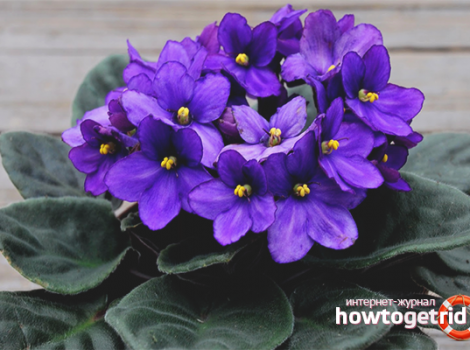Content
Green stems and delicate tulip flowers look very impressive against the background of icy window panes. Friends will surely be surprised when, in the middle of a snowy winter, they see a multi-colored lawn on the windowsill in your apartment. These amazing flowers will bring you a lot of joy and brighten up the long wait for the spring sun.
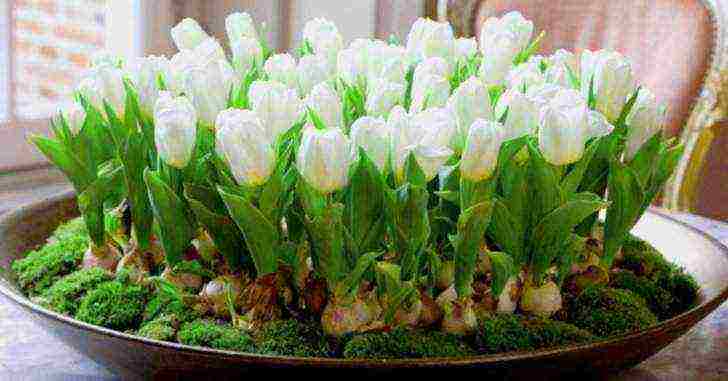
Growing tulips at home is not too difficult, and the bulbs can also be used next season.
You should not strive for rare, exotic varieties from the very beginning. Much less whimsical undersized tulips are best suited for a tiny flower bed. They are quite durable and do not require too painstaking care.
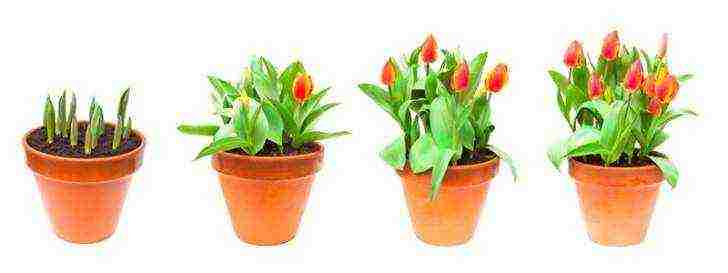
Even novice gardeners can handle this challenge. Moreover, if you follow our step-by-step instructions. So, let's begin:
1. How to choose the right bulbs for planting.
The main thing is that they are intact and not have external damage. The old and tough husk must be removed and the bulbs must be held for half an hour in a weak solution of potassium permanganate. You can also use special antimicrobial drugs. They are now sold in assortment in gardening stores.

2. How to prepare the soil.
The quality of the soil is of great importance. You can buy specially prepared land or use homemade land from your own plot. But at the same time, the soil should certainly be loosened. You need to add about 5 grams (teaspoon) of nitrogen fertilizer per kilogram of soil. At the bottom of the bowl or pot, always with a hole to remove excess moisture, it is necessary to put drainage. Then pour the prepared soil into the pot almost to the top.

3. How to plant bulbs.
Just spread them out on top of the soil. Place them upside down and tight enough. Cover the top with a layer of soil and water liberally. Now you can take the tulip container to a dark, damp and cool place. Please note that the temperature should not exceed 12 degrees Celsius.
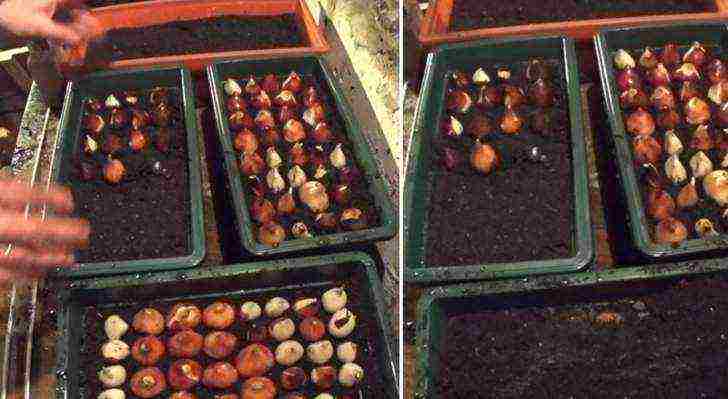
4. How to achieve flowering.
Watering the future flower garden should be at least once a week. When sprouts appear, move the pot to a warmer room. It is desirable, of course, that the temperature rises gradually until it reaches the optimum - 16 degrees. Very soon, timid sprouts will turn into strong stems, and then, after ten days, buds are already formed. And after another week, beautiful flowers will finally bloom. In this case, you should not use additional sources of heat, because the flower will quickly lose the petals. We recommend that you immediately move the tulips closer to the cold window glass, then they will retain their pristine freshness longer.
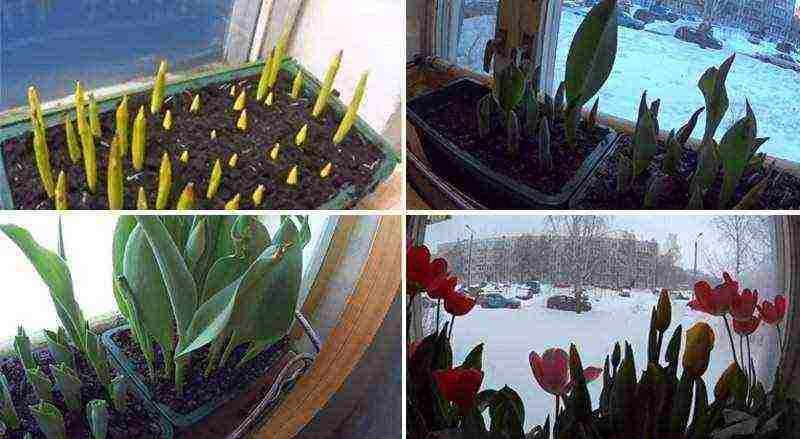
As you can already see, growing these spring flowers at home is not too tedious and troublesome. It does not require additional equipment, a special cellar or greenhouse. A glazed balcony is fine. And for planting, you can use containers of any size. A tiny pot is suitable for a couple of bulbs, and a wide box is suitable for a full-fledged flower bed.

You can also plant different types of bulbs in one pot at different depths.Then they will sprout and bloom at different times. And you will always have bright and fresh flowers on your windowsill. Try not only tulip bulbs, but other spring flowers as well. For example, you can arrange the so-called "flower lasagna", that is, plant crocuses, daffodils and hyacinths in one container.

A couple more important tips. If you absolutely need tulips to bloom by March 8th, then they should be planted in late November or early December. This already largely depends on the variety. But on average, it takes about four months from the moment of planting to the beginning of flowering.
Note that for small bulbs, it is better to use low containers. You need to choose ceramic pots, they allow air to pass through and protect the roots of plants. Plastic containers heat up easily and block oxygen access.
As you can see, it is not at all difficult to create a flower bed of colorful tulips on your own windowsill. And if you don't have enough time to do forcing, don't be upset. You can always get houseplants that bloom all year round. You will only need to water them and enjoy the fragile and delicate beauty.
Knowing how to grow tulips at home, you will create a real spring flower garden in your own apartment. What recommendations should be followed by a florist, and how to properly care for such plants at home, we will find out in detail.
Home cultivars
In order for planting tulips in pots to give the desired result, it is necessary to correctly choose the varieties of this flower. Not all varieties of this spring culture can be safely rooted at home. Perhaps, many flower growers will want to replenish their collection with exotic tulip species. However, this is not the right decision.
The thing is that rare plant species are very capricious and do not take root too well in a private house or city apartment. It is much better to give preference to varieties that you have previously grown without problems in the open field. The proven types of tulips include Aristocrat, Oxford, Parade, Diplomat, Negrita, London, etc.
For home cultivation, first of all, low-growing varieties of tulips are suitable. They are unpretentious in care and are distinguished by excellent resistance to various diseases.... Pay attention to this factor, as it will be much easier for you to achieve flowering with these types of tulips.
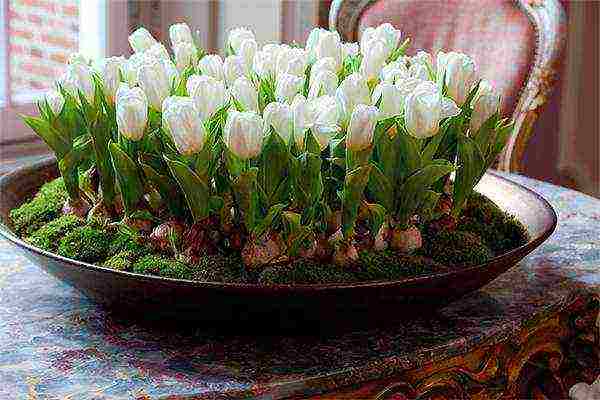
Preparing for landing
Many people probably thought about how to grow tulips at home. This is the real highlight of the apartment flower garden: bright buds that adorn the dwelling when frosts are still raging outside the window. But in order to achieve the desired result, you need to take care of all the preparations, from the selection of planting material to the composition of the soil. Let's take a closer look at all these requirements.
Preparation of planting material
It is recommended to choose the largest bulbs for planting. Make sure they are all large and have the same shade. It is advisable to inspect each specimen and make sure that there is no rot, suspicious spots and dots on it. Another key point when choosing a planting material is the weight of the bulb. It should be at least 25 g. Otherwise, there will be no flower bud in the core, that is, the plant will never hatch out of the ground.
Pot and soil selection
It is necessary to grow indoor tulips in a fairly spacious and practical container, so it is recommended to pay special attention to its choice. Prefer wide specimens, especially if you plan on planting several bulbs at a time. However, it is better not to buy deep vases, since tulips have a small root system.

As for the soil mixture, pure peat or a composition with the addition of a sand layer is considered the best option for rooting tulips. Some growers prefer to fill the pot with perlite or ordinary garden soil. In this case, you cannot do without fertilization: the substrate will need to be saturated with compost, manure or a small amount of wood ash. All key components are recommended to be thoroughly mixed and moistened.
Boarding time
How to grow tulips in your own apartment on the balcony - many flower growers think about this. The main thing is to follow the key recommendations of specialists, purchase high-quality planting material, and carefully prepare the soil mixture. However, rooting time is considered an equally important factor affecting the effectiveness of planting tulip bulbs.
If you want to enjoy the beauty of bright buds already in the second half of winter, plant the plant in September-October.
The necessary conditions
Growing low-growing tulips at home is a laborious task. You need to create an optimal microclimate for them, which means that you will have to take care of high-quality lighting of flowers, regular watering, fertilizing, as well as protecting tulips from diseases and parasites. We will try to find out what exactly is recommended for a novice florist.
Video "Forcing tulips and bulbs"
Forcing bulbous flowers in winter.
Illumination
To grow tulips on a balcony or windowsill, you need to create favorable conditions for them to germinate. These include, first of all, lighting. It should not be overly bright, freshly planted plants can even be covered with a paper cap to gradually accustom them to daylight. Soon, such a shelter can be removed.
Temperature and humidity
After you have planted the bulbs in the ground, they also need to ensure the optimal temperature and humidity level in the room. Initially, the temperature readings should not exceed the +10 ° C mark. That is why a flowerpot with planted tulips can be carried to the basement or to the balcony. Regarding humidity, it is very important here that the air around the flower pots is not dry. Place them away from hot batteries or heaters.
Landing technology
To plant bulbs in an apartment and wait for tulips to bloom, observe the following conditions:
- immediately before rooting, carefully inspect the planting material, and then disinfect it in a weak solution of potassium permanganate;
- lay a drainage layer on the bottom of the flower pot, use sphagnum moss if desired;
- fill the pot with substrate and then spread the bulbs;
- cover them with earth to the very tops;
- moisten the soil and then add another layer of soil.
After planting tulips, place the container with bulbs in a dark, cool place for several days.
Further care
When all the recommendations for rooting tulips have been followed by you, all that remains is to provide them with proper care. It is necessary to grow them in the ground, not forgetting about regular watering, as well as saturation of the substrate with nutrients. What exactly is required of you, we will consider below.
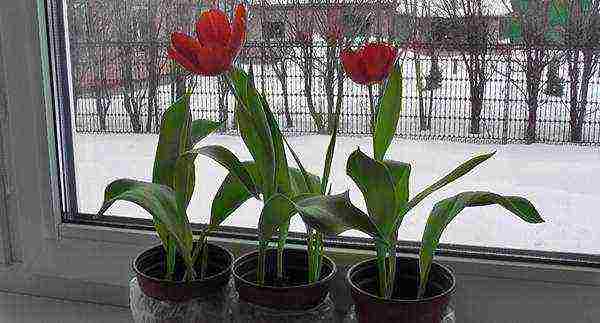
Watering features
Full care of home tulips is, first of all, regular watering.
It is necessary to moisten the substrate at least twice a week. In general, you need to steadily control the level of soil moisture. As soon as the topsoil begins to dry out, it's time to water the flowers. Water at room temperature must first be defended.
Plant feeding
Florists who want to plant and grow tulips at home should not forget about the need to saturate the soil with useful microelements. Top dressing is recommended twice a month. You do not need to prepare the formula yourself.Many people prefer to buy ready-made formulations in specialized stores. Be sure to follow the dosage indicated in the instructions. Otherwise, the plant may turn yellow and bloom less intensely.
Taking care of domestic tulips is not easy. But if you control their development at every stage, you will definitely wait for their abundant flowering.

Imagine how surprised your guests will be to see that you are growing tulips at home! Spring-like green stems with exquisite buds of a wide variety of colors look unusually impressive against the background of white snow outside the window. Delicate bulbous flowers grown on the windowsill will not only become your pride, but also brighten up the long wait for spring.
Tulips suitable for home cultivation

Tulip photo
This is not to say that growing tulips at home is a simple activity that is accessible even to a child. Despite the unpretentiousness of this culture, it is necessary to follow certain rules when planting bulbs and provide the growing flowers with proper care during the entire growing season. Then the results will be pleasing to the eye.
If you are seriously interested in how to grow these Dutch beauties, you have to stock up on containers for flowers, prepare a substrate, choose a suitable place where they will grow comfortably, and start planting bulbs at a favorable time. Our article will help you do everything right and avoid mistakes.
Video about growing tulips at home
Not all species grow well at home. Of course, it would be very tempting to grow tulips of unusual colors on the windowsill - brown, blue, purple, black, etc. However, exotic varieties are quite capricious, so for home cultivation it is better to use proven varieties: Aristocrat, Christmas Marvel, Oxford, Epricot Beauty, Parade, Fringit Elegance, Diamond Star, Diplomat, Lustige Battle, Bridge Miles, Negrita, Confux, London, Temple of Beauty , Apeldoorn, Eric Hofsier, Scarborough. Even novice flower growers can cope with the cultivation of such an unpretentious variety as Parade Record (Darwin hybrids).
When choosing flowers for growing, it is worth giving preference to low-growing varieties that are resistant to diseases (especially variegated leaves), unpretentiousness to growing conditions and are able to tolerate minor disturbances during care.
Purchased planting material is already completely ready for forcing - the bulbs are sorted and processed, so they can be planted immediately. If you decide to independently prepare planting material from tulips growing in the garden, you will need to provide them with thorough care throughout the growing season: feed, water, loosen the ground and destroy weeds. In this case, you need to dig up the plants as soon as the stems begin to turn yellow.
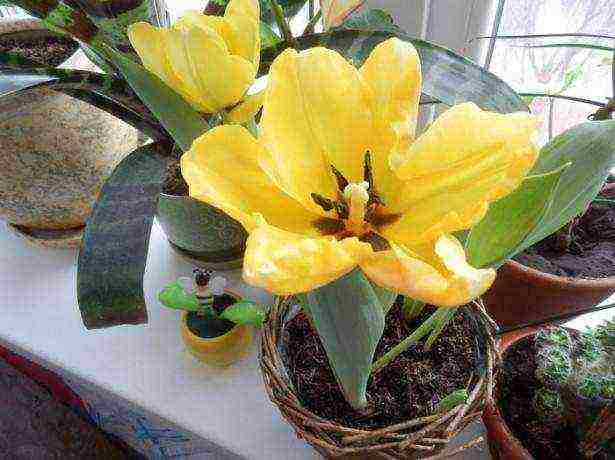
In the photo, homemade tulips
Select the largest of the bulbs dug out and send them to dry in a dry room. In this case, the following temperature regime must be maintained: the first week + 34 ° С, then two months + 23 ° С, and the last month + 17 ° С. After that, the planting material must be placed for cooling in a box or gauze bag on the lower shelf of the refrigerator (or in the basement), where it is stored until planting at a temperature of +5 ° C.
Planting flowers at home - step by step instructions
Growing tulips at home is based on forcing technology: artificially created conditions for plants are similar to natural ones. At the same time, special attention is paid to cooling the bulbs, because in nature they form shoots and flowers only after they have passed the stage of winter rest. Another thing is that the technology of distillation by controlling the temperature regime allows you to get fresh flowers in the middle of winter or early spring - at the request of flower growers.
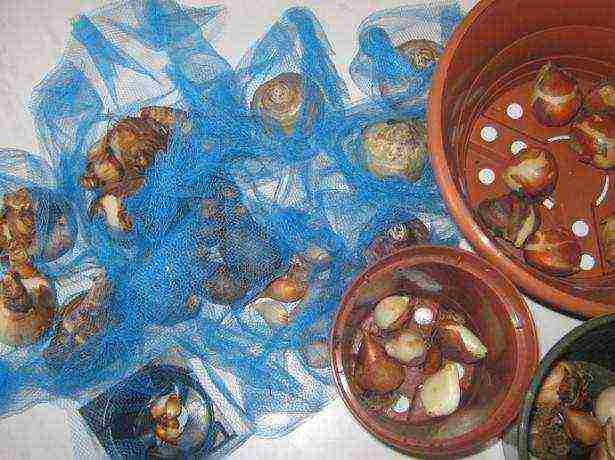
In the photo bulbs and pots for tulips
So, the bulbs are ready for planting, it's time to figure out how to plant them at home:
- you can start planting at the end of September;
- prepare pots or bowls at least 15 cm deep;
- mix the substrate from the river stove, sod land and humus (1: 2: 1), add a little wood ash to the substrate, or buy a ready-made soil mixture with good water permeability and a neutral reaction;
- Before planting, inspect the bulbs from all sides for diseases and dip them in a solution of potassium permanganate for half an hour;
- put drainage in bowls or pots (you can use sphagnum moss) and fill the container with the substrate so that the distance to the edge remains three times more than the height of one onion;
- spread the planting material on top of the ground, bottom down, one centimeter apart;
- fill the onions with the substrate to the tops;
- water and top up the soil mixture if the tops of the bulbs appear from under the ground;
- transfer the pots with plantings to a dark room, where the humidity is 80%, and the temperature is not higher than + 9 ° C.
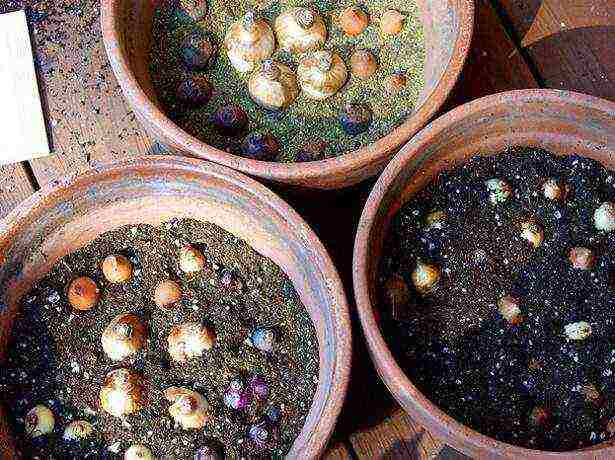
Photo of planting tulips in pots
Planting should not be left unattended - make sure that the ground does not dry out, but also does not mold. Weekly watering will be sufficient.
How to achieve flowering and prolong it
After a few weeks, you will notice that the potted bulbs are sprouting. As soon as the seedlings reach a height of 6-7 cm, it is time to transfer them to the room and gradually accustom them to daylight, at first covering them with a paper cap. It is desirable that the temperature also rise gradually, within two to three days, up to +18 ° C. At higher temperatures, tulips will form weak, thin peduncles, possibly even fusarium infestation.
If you are growing flowers in winter, provide artificial light for ten hours, otherwise the stems will be very elongated and the color will be pale.
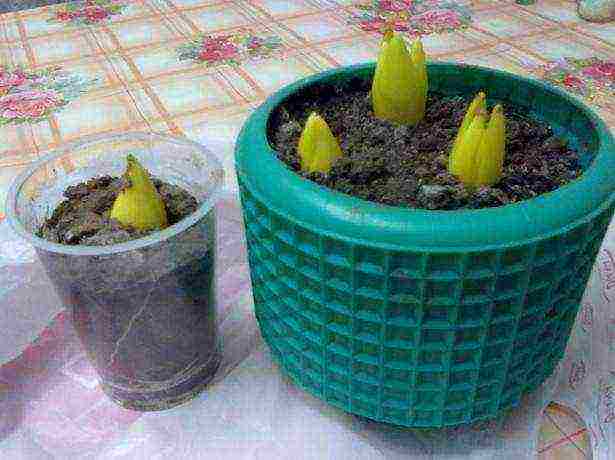
Photo of tulips in a pot
With the appearance of colored buds, it is recommended to rearrange the pot closer to the cold glass of the window, since at a lower temperature, the flowering period will stretch, and you will be able to admire the delightful flowering longer.
To extend the flowering period, it is also advisable to take out the pots with plants to the balcony at night, and during the day to spray the leaves with warm water (without getting on the flowers). The required air humidity level for tulips is about 80%. The soil should also be constantly slightly moistened.
Important subtleties:
- the bright sun should not shine on the flowers;
- protect plants from drafts;
- keep pots as far away from central heating radiators as possible;
- for irrigation, it is recommended to use settled water at room temperature;
- cut domestic tulips at the very surface of the earth, in the early morning before watering.
Video about growing tulips
After home cultivation, the bulb is greatly depleted and it is no longer possible to reuse it for the same purpose, but you can plant it on the garden bed - the bulbs will recover in the open field, and the next year they will bloom again (but already in the flowerbed). Therefore, with the end of flowering, the buds break off and gradually reduce watering until the leaves turn yellow, then the bulbs are dug up, dried and stored at a temperature of +14 degrees in a dry basement.
The video attached to the article will allow you to better understand how to plant tulips at home. Following the recommendations, you will definitely be able to achieve excellent results and admire the exquisite buds on long winter evenings in anticipation of spring.
 Many gardeners grow potted tulips at home to please their soul mate on March 8th or to profit from the further sale of flowers.
Many gardeners grow potted tulips at home to please their soul mate on March 8th or to profit from the further sale of flowers.
In most cases, these plants develop in a flower bed, but early flowering can be obtained by planting bulbs in ordinary pots in winter.
Our article will be devoted to the process of growing tulips in flowerpots.
Description
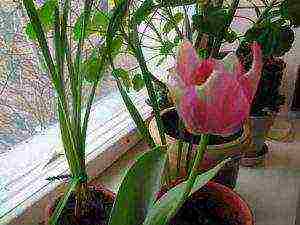 Depending on the selected variety, the height of a tulip can range from 10 centimeters to 1 meter. The root part of this plant consists of adventitious roots that develop and die off every year.
Depending on the selected variety, the height of a tulip can range from 10 centimeters to 1 meter. The root part of this plant consists of adventitious roots that develop and die off every year.
The stem of the flower is erect, cylindrical in shape. The leaves are elongated lanceolate, green with a barely noticeable waxy bloom. The bottom leaf is considered the largest, the largest leaf blade is in the upper part of the culture.
Note: most tulip varieties have only one inflorescence, but some species can form three to five flowers at the same time.
Inflorescences are white, yellow or red, consist of 6 petals and the same number of stamens. In hybrid varieties, the color is slightly different, in this case the flowers can be purple or violet.
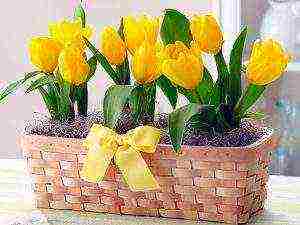 Tulip petals also have different shapes:
Tulip petals also have different shapes:
- bowl-shaped;
- star-shaped;
- fringed;
- oval;
- lily-shaped.
The size of the blossoming inflorescence also depends on the variety. If the length of a flower can reach 12 centimeters, then the diameter of the inflorescence ranges from 3 ... 10 centimeters. Tulips usually open in cloudy weather and finish flowering at nightfall or in adverse weather conditions.
For home cultivation
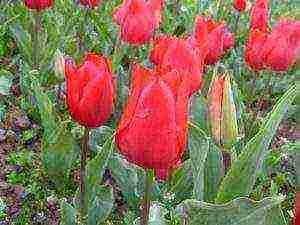
Variety London
The selection of tulips is actually huge, but not all varieties are suitable for growing at home, in a pot. The most adapted crops include:
- London;
- Oxford;
- Parade Record;
- Aristocrat;
- Negrita;
- Scarborough;
- Confux;
- Diplomat.
It's important to know: short plants are ideal for growing at home. Such crops are undemanding to care for and have good disease resistance.
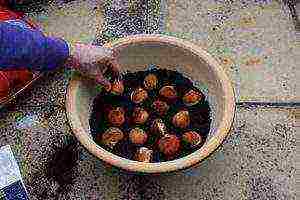 Tulip bulbs can be purchased at any specialty store or prepared from your own planting material. There are some nuances in using your seeds:
Tulip bulbs can be purchased at any specialty store or prepared from your own planting material. There are some nuances in using your seeds:
- Their flowers need careful care during their development.
- The bulbs are dug in the spring after the tulips have faded during the yellowing of the stems.
- The largest bulbs are selected for storage and further planting.
When drying seed, the following temperature regime must be observed. In the first week of storage, the room temperature is set at 34 degrees. In the next two months, temperature indicators are reduced to +23 degrees.
In the next third month, the temperature is again reduced to +17 degrees. After a while, the bulbs are placed in a gauze bag and placed in the refrigerator. In this state, the seed is stored until planting.
Preparatory work for forcing bulbs
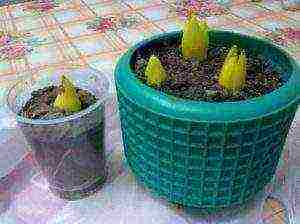 Winter cultivation of tulips consists in the use of forcing technology.
Winter cultivation of tulips consists in the use of forcing technology.
In the process of basic work, the gardener must bring the temperature and humidity of the air, as well as lighting, as close as possible to natural conditions.
The main work on growing tulips at home is carried out in the following sequence:
- Planting of bulbs takes place in the last decade of September.
- For growing flowers, flowerpots are chosen up to 15 centimeters in depth.
- You can buy potting soil or make your own. It consists of one part of humus and river sand and two parts of sod land. To enrich the earth with microelements, a little wood ash is introduced into its composition.
- We examine the bulbs for the presence of diseases, lower the planting material for 30 minutes in a solution of potassium permanganate for disinfection.
- We put the drainage in pots, fill them with a nutrient mixture.
- We spread the bulbs on the soil surface, maintaining a distance of 1 centimeter.
- We fill the planting material with soil.
- We water the soil.
- Move the pots to a dark, but damp and cool room.The temperature in this place should not exceed +9 degrees, the humidity is within 80%.
Keep in mind: the bulbs need to be refrigerated before planting, which will stimulate intensive crop development.
Further care of flowers consists in additional watering. The soil must be moistened at least 1 time per week.
How to achieve flowering
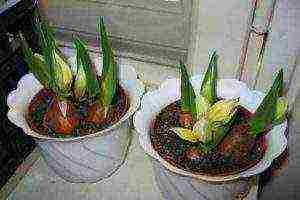 A few weeks after sowing, the first shoots will begin to emerge from the pots. When the height of the leaves reaches 6 or 7 centimeters, they are transferred to a bright room and gradually begin to accustom them to sunlight.
A few weeks after sowing, the first shoots will begin to emerge from the pots. When the height of the leaves reaches 6 or 7 centimeters, they are transferred to a bright room and gradually begin to accustom them to sunlight.
Experienced gardeners recommend moving a flower with an unblown bud to a cold glass, which will extend the flowering period. For the same purpose, pots with crops are taken out onto the balcony.
In the room, it is necessary to achieve optimal air humidity (about 80%). Such indicators can be obtained with periodic spraying of plants.
 When growing flowers at home, the following rules must be observed:
When growing flowers at home, the following rules must be observed:
- plants should not be exposed to direct sunlight;
- it is necessary to protect growing crops from drafts;
- keep the pots away from heating radiators;
- to moisten the soil, settled liquid is used, with a temperature of 18-22 degrees.
- flowers should be cut in the morning near the surface of the earth.
Gardener tip: for the first time after moving, the flowers should be covered with a paper cap. The temperature also needs to be raised gradually to +18 degrees in two days. When growing tulips in winter, artificial lighting may be needed.
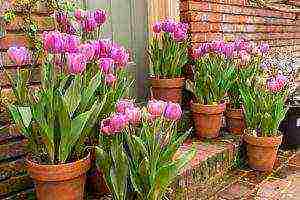 It is not recommended to use the bulb for re-distillation of tulips, but the planting material can recover in the open field. In this regard, after the end of flowering, it is necessary to cut the bulb and reduce watering.
It is not recommended to use the bulb for re-distillation of tulips, but the planting material can recover in the open field. In this regard, after the end of flowering, it is necessary to cut the bulb and reduce watering.
After the leaves turn yellow, the bulbs are removed from the soil and dried. Planting material is stored in the basement, where the temperature is +18 degrees.
Growing tulips on your own in winter is quite simple, but for this you need to follow the rules described above. With proper care, these flowers will delight the hostess with colorful inflorescences and long flowering.
How to plant tulips in pots correctly, see the following video:


